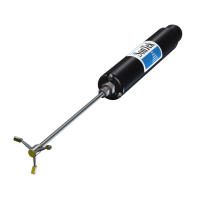SonTek/YSI
86
ADVField Operation Manual (September 1, 2001)
5.8. Seeding Requirements
If ADV velocity data appears “noisy”, it may be due to a lack of scattering material in the water
(see the
ADV Principles of Operation
for general information about the ADV). This can be
remedied by adding seeding material. When collecting data at 25 Hz under good operating condi-
tions, the ADV noise level is expected to be about 1% of the velocity range (i.e.; each 25-Hz
sample has noise of about
±
1 cm/s when using the
±
100 cm/s velocity range). If there is insuffi-
cient scattering material in the water, resulting in low SNR values (less than 5-10 dB), noise lev-
els will increase.
In most laboratory applications, and almost all field applications, there is sufficient scattering
material naturally present for ADV operation. In large, quiet basins, the water may need to have
seeding material added. When practical, we recommend using particles that have a density close
to that of water and a mean diameter of 10-20 µm. Neutrally-buoyant particles remain in suspen-
sion without additional stirring and are ideal for low-flow experiments. The choice of size is mo-
tivated by the relatively strong echo that these particles generate per unit of concentration.
Smaller particles (e.g.; 1 µm particles used for Laser Doppler systems) are not recommended be-
cause the required concentration is quite high.
A small bottle of seeding material is included with the ADV and should be sufficient for general
testing purposes. The recommended seeding level is 10-50 mg/L. This material consists of hol-
low glass spheres with a mean diameter of about 10 µm. Additional seeding material (for small
quantities) is available from SonTek. The seeding material has not been found to have any ad-
verse effects on the performance of Laser Doppler Velocimeters. For applications requiring large
quantities of seeding material, you can order directly from the manufacturer listed below.
Potters Industries Phone: (610) 651-4709 Part number: 10030
PO Box 840 Fax: (610) 408-9723
Valley Forge, PA 19842 USA www.pottersbeads.com
5.9. Anti-Fouling Protection
The ADV has excellent fouling resistance and can operate reliably even with biological growth
on the transducers. Biological growth causes a loss in signal strength (reducing the signal to noise
ratio (SNR)), but does not affect the accuracy of the velocity measurements unless the SNR is
very low (less than 5 dB). To prevent biological growth, the ADV can be painted with anti-
fouling paint following the procedure below.
Within the United States, we recommend using an anti-fouling paint called Interlux Tri-Lux II.
This contains a biocide that is a copper derivative that can be used on all metals, including alu-
minum. For information on Interlux paints, contact:
Interlux Yacht Finishes Phone: (908) 686-1300
2270 Morris Avenue Fax: (908) 686-8545
Union, NJ 07083 USA www.yachtpaint.com
Normal anti-fouling paints, which use coprous oxide based biocides, cannot be used on alumi-
num as they cause galvanic corrosion. Outside the United States, anti-fouling paints containing
TBT can be used on aluminum systems with a suitable primer. On plastic systems, any type of
anti-fouling paint can be used.

